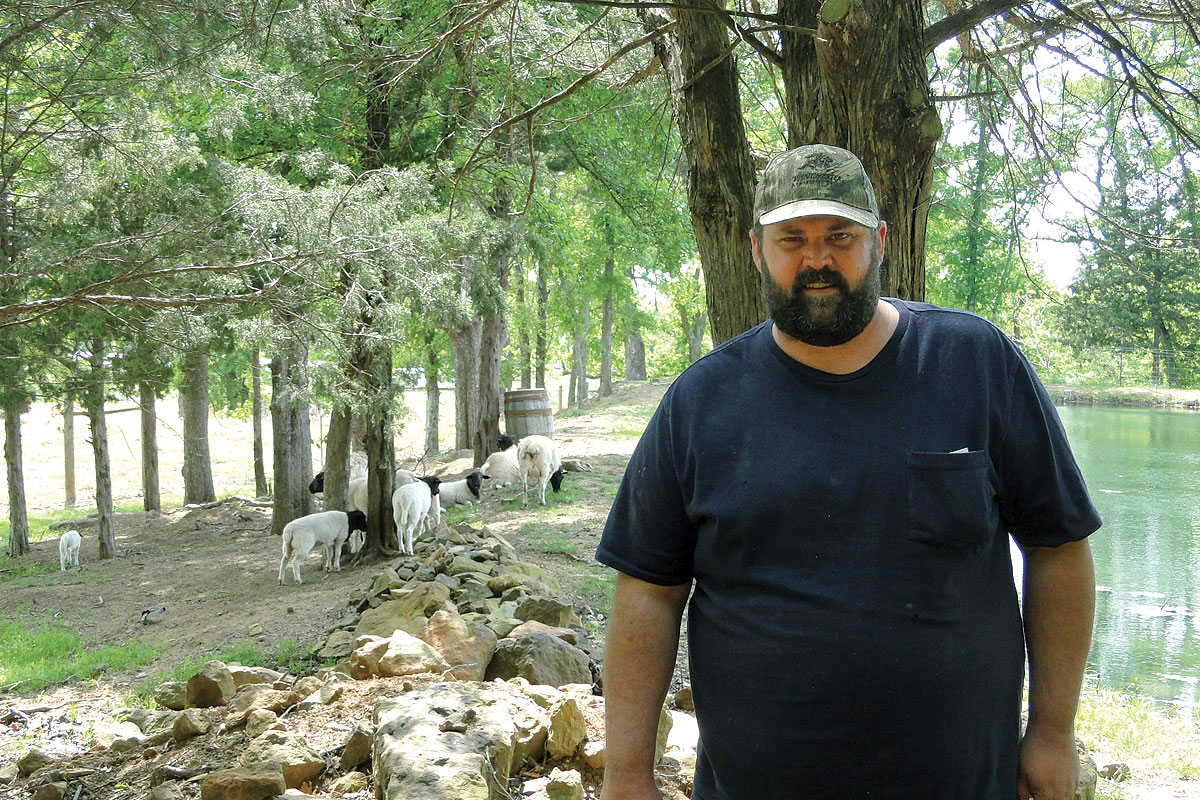
Ryan Callison says the size of his Dorper herd fits his goals
Emerson had Walden Pond, and Ryan Callison has 20 picturesque and partially shaded acres in Gore, Okla., surrounding a beautiful pond which provides water for Muscovy ducks, Dorper sheep and a handful of chickens.
While his father Tom still owns the house, Ryan owns the land and uses an additional 10 acres owned by a neighbor. The name of the farm is Roundtop Dorpers.
Ryan has always had an interest in the life sciences but his school did not possess a strong ag program so he had little chance to pursue the academic side of the sciences. However, Ryan did live in the country on the land he now owns. From junior high on, he always had animals in order to make spending money. He began with rabbits, which suited the limited space and were easy to care for. He sold rabbits and supplemented that income by picking up and recycling aluminum cans.
Then he attended Connors State College in Warner, Okla., and finished at Northeast State University in Tahleequah, Okla., graduating with a bachelor’s of science in environmental management, followed by a master’s in industrial management.
Ryan’s careers have been as diverse as his education with his first job being a mapmaker for the Cherokee Nation. He retired as environmental director for the Cherokee Nation’s Environmental Programs Department. He has served as mayor of Gore for 13 years and still serves on the City Council. Ryan’s other jobs have included being a tow truck driver and working for the U.S. Veterans Administration.
“I’ve had a three-year break and have focused on my sheep, but I’m now considering a new and totally different career though I haven’t yet decided what that is exactly,” Ryan said.
Ryan raises Dorper sheep as breeding stock or for live meat sales. At one time, the herd was up to 50 ewes, but it was more work than Ryan and his brother Dustin could handle. Now that Ray is considering a new career, the current herd size of 16 ewes and a handful of lambs is far more reasonable.
When purchased as breeding stock, registration at a cost of $20 is possible but most buyers have commercial herds and find the expense unnecessary. As typical with most goat and sheep meat sales, purchases tend to cluster around the holidays.
“I can quickly sell as many animals as I can raise, but this herd size fits the land and my current goals. My biggest challenge is having enough people around to help with the sheep if an issue does come up because I want enough people so no one gets hurt. Boys from 4-H often help with a variety of farm tasks such as treating the pond and repairing fence,” Ryan explained.
The ram is left with the herd year round, though births are most frequent during spring and fall. Because of the gestation period of 150 days, a sheep can give birth three times within two years.
“Rams can never be trusted and are always looking for an opening to get at you. They want to butt you, and I once had to jump an electric fence. Another time my brother received a serious injury,” said Ryan.
Ryan gained most of his knowledge about raising sheep through Oklahoma State University’s online goat and sheep school. He also learned from a neighbor who encouraged Ryan to raise sheep and who even traded a ram and two ewes for a trailer to help Ryan out. Other valuable information came from the USDA and its programs.
Ryan rarely uses antibiotics and then only for injuries. He keeps all of the necessary records of birth date, illnesses, injuries, deaths and vaccinations, which he and Dustin use mostly for themselves but will share with prospective owners if they are interested. Ryan uses the FAMACHA test, which ranks eye color as a means of determining if treatment for worms is necessary. Milky eyes and a fat ball under the chin are the main indicators. An infected animal is then isolated and given two broad spectrum treatments in three days before being returned to the herd. Other practices included banding some males and all lambs having their tails docked. Ray follows the practice because of the old-school belief that docking the tails to make waste elimination cleaner and to ease prolapse, breeding and birthing issues. Finally, Ryan purchases 200 square bales and 10 big round bales of Bermuda mixed hay locally to supplement grazing in the winter.
Always on the lookout for the unusual, Ryan decided to raise Muscovy ducks after he learned of them from a woman at work. The birds are heavier than traditional domesticated ducks, with males weighing up to 15 pounds. They are more full-bodied with beautiful black and white patterns and different colored beaks. While the name of the breed is Russian and refers to Moscow, the breed is actually native to Mexico and South America but adapts well to cooler climates. They do not migrate and were domesticated by Native Americans before Columbus arrived. Ryan has 50 hens and three drakes that supply meat and eggs for marketing.
“I love this land and expect I will always be raising something, said Ryan.






